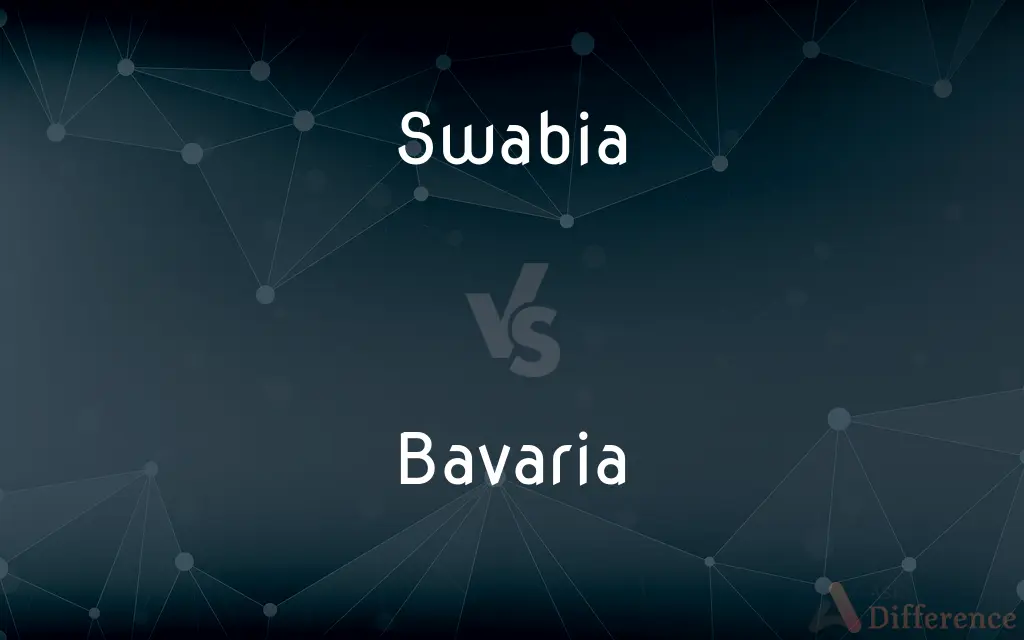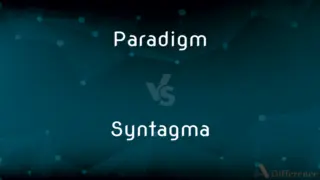Swabia vs. Bavaria — What's the Difference?
By Tayyaba Rehman & Urooj Arif — Updated on April 5, 2024
Swabia and Bavaria are distinct regions in Germany, known for unique dialects and cultural traditions, with Bavaria being larger and more internationally recognized.

Difference Between Swabia and Bavaria
Table of Contents
ADVERTISEMENT
Key Differences
Swabia is a cultural and historical region in southwestern Germany, characterized by its own distinct German dialects, traditional costumes, and folklore. It's known for its picturesque landscapes, including the Swabian Jura and parts of the Black Forest. Whereas Bavaria, located in southeast Germany, is the largest German state by land area, famous for its rich cultural heritage, Oktoberfest, and landmarks like Neuschwanstein Castle. Bavaria also boasts a unique identity, with its own dialect, traditional clothing such as Lederhosen and Dirndl, and a strong sense of regional pride.
In terms of language, Swabians speak Swabian German, a group of Alemannic dialects that significantly differ from Standard German, making it challenging for outsiders to understand. This linguistic identity plays a crucial role in the region's culture. On the other hand, Bavaria is home to Bavarian German, a group of Upper German dialects. Bavarian dialects also vary significantly from Standard German, but like Swabian, they are an integral part of regional identity, with distinct differences even within the region.
Economically, Swabia is known for its industriousness, with a strong manufacturing sector, especially in automotive, engineering, and technology fields. Cities like Stuttgart and Ulm are economic powerhouses, hosting headquarters of major corporations such as Daimler AG and Bosch. Conversely, Bavaria has a diverse economy, excelling not only in manufacturing (with companies like BMW and Siemens) but also in agriculture, tourism, and information technology. Munich, Bavaria's capital, is a significant cultural and economic center, often ranked as one of the most livable cities in the world.
Swabian cuisine emphasizes simple, hearty dishes often made from local ingredients, with specialties such as Spätzle (egg noodles), Maultaschen (stuffed pasta), and Lentils with Spätzle. These dishes reflect the region's agricultural heritage and are central to its cultural identity. In contrast, Bavarian cuisine is famous for its rich, meat-heavy dishes, such as Weisswurst (white sausage), Knödel (dumplings), and Schweinshaxe (pork knuckle). Beer is also a central element of Bavarian culture, with the state being home to some of the oldest breweries in the world.
Culturally, Swabia and Bavaria share a deep-rooted history and a strong sense of regional identity, each with distinctive traditions, festivals, and folklore. However, Bavaria often enjoys greater international recognition, partly due to the global fame of Oktoberfest and iconic landmarks. Swabia, while perhaps less known globally, maintains a rich cultural fabric with deep historical roots and a strong commitment to preserving its unique traditions and dialect.
ADVERTISEMENT
Comparison Chart
Location
Southwestern Germany
Southeastern Germany
Language
Swabian German dialects
Bavarian German dialects
Economic Strength
Manufacturing, automotive, engineering
Manufacturing, agriculture, tourism, IT
Cuisine
Spätzle, Maultaschen, Lentils with Spätzle
Weisswurst, Knödel, Schweinshaxe, Beer
Cultural Identity
Strong, with unique traditions and folklore
Strong, with unique traditions, Oktoberfest, global recognition
Compare with Definitions
Swabia
An area with a strong manufacturing and technological industry.
Swabia is home to leading companies in the automotive sector.
Bavaria
A region where Bavarian German, a group of Upper German dialects, is spoken.
The Bavarian dialect varies significantly across the region, contributing to its rich linguistic tapestry.
Swabia
A cultural and historical region in southwestern Germany, known for its distinct dialects and traditions.
Swabia's picturesque villages and landscapes are emblematic of the region's rich heritage.
Bavaria
The largest state in Germany, renowned for its cultural heritage, Oktoberfest, and beautiful landscapes.
Bavaria attracts visitors from all over the world with its castles and traditional festivals.
Swabia
A region with a distinct cultural identity, including traditional costumes and festivals.
Swabia celebrates unique festivals that highlight its folk traditions and history.
Bavaria
Known for a strong sense of regional pride and identity, with globally recognized cultural symbols.
Bavarian traditions, such as wearing Lederhosen and Dirndl, are celebrated both within and outside Germany.
Swabia
Known for its traditional cuisine, including dishes like Spätzle and Maultaschen.
Swabian cuisine is a reflection of the region's agricultural roots and culinary traditions.
Bavaria
Economically diverse, with strengths in manufacturing, agriculture, and technology.
Bavaria's capital, Munich, is a significant cultural and economic hub.
Swabia
The region characterized by its own version of the German language, known as Swabian.
Understanding the Swabian dialect can be challenging for those not from the region.
Bavaria
Famous for its traditional cuisine and beer culture, including Weisswurst and various local breweries.
Bavarian beer gardens are a central aspect of the state's social life and culture.
Swabia
Swabia is a cultural, historic and linguistic region in southwestern Germany. The name is ultimately derived from the medieval Duchy of Swabia, one of the German stem duchies, representing the territory of Alemannia, whose inhabitants interchangeably were called Alemanni or Suebi.
Bavaria
Bavaria (; German and Bavarian: Bayern German pronunciation: [ˈbaɪɐn]), officially the Free State of Bavaria (German and Bavarian: Freistaat Bayern; German: [ˈfʁaɪʃtaːt ˈbaɪɐn] (listen)), is a landlocked state (Land) in the south-east of Germany. With an area of 70,550.19 square kilometres (27,239.58 sq mi), Bavaria is the largest German state by land area, comprising roughly a fifth of the total land area of Germany.
Bavaria
A state in southern Germany.
Bavaria
A state in southwestern Germany famous for its beer; site of an automobile factory
Common Curiosities
Do Swabia and Bavaria share any cultural similarities?
Both regions have a strong sense of regional pride, deep-rooted historical traditions, and unique dialects that are central to their identities, despite their differences.
What distinguishes Swabian from Bavarian dialects?
Swabian and Bavarian dialects belong to different groups of the German language, with unique phonetic and lexical characteristics that reflect their distinct cultural backgrounds.
How does the economic landscape differ between Swabia and Bavaria?
Swabia is heavily industrialized with a focus on manufacturing and engineering, while Bavaria has a more diversified economy that also includes strong agricultural and tourism sectors.
How have Swabia and Bavaria maintained their cultural heritage in modern times?
Both regions have actively preserved their cultural heritage through museums, cultural festivals, traditional crafts, and the teaching of dialects in schools and community groups, ensuring their traditions are passed down to future generations.
Why is Bavaria more internationally recognized than Swabia?
Bavaria's global recognition can be attributed to its iconic cultural events like Oktoberfest, famous landmarks, and a strong promotional push that highlights its unique cultural identity.
What role do traditional costumes play in Swabia and Bavaria?
Traditional costumes, or Trachten, play a significant role in both regions, symbolizing local identity and heritage, with specific styles and occasions for wearing them, such as festivals and weddings.
How do Swabia and Bavaria contribute to Germany's tourism?
Swabia attracts tourists with its natural landscapes, such as the Swabian Jura and parts of the Black Forest, while Bavaria is a major tourist destination for its historic cities, castles, and the world-famous Oktoberfest.
How do the dialects of Swabia and Bavaria affect communication with the rest of Germany?
The distinct dialects of Swabia and Bavaria can sometimes pose challenges in communication with non-local speakers, as they differ significantly from Standard German, especially in pronunciation and vocabulary.
What are some must-visit places in Swabia and Bavaria for a first-time visitor to Germany?
In Swabia, the Ulm Minster and Hohenzollern Castle are must-visits, while in Bavaria, Neuschwanstein Castle, Munich's Marienplatz, and the Bavarian Alps are essential for first-time visitors.
Can Swabian and Bavarian cuisines be easily distinguished?
Yes, Swabian cuisine is known for its hearty, simple dishes often incorporating noodles and lentils, whereas Bavarian cuisine is richer, with a focus on meat dishes and beer.
Are there any notable rivalries or friendly competitions between Swabia and Bavaria?
There are regional rivalries and friendly competitions, especially in football (soccer) and cultural festivals, reflecting a long history of distinct identities but also mutual respect and cultural exchange.
What are some key historical differences between Swabia and Bavaria?
Historically, Swabia was a duchy in the Holy Roman Empire, known for its fragmented political structure, while Bavaria was a more unified and powerful duchy, which has evolved into a significant cultural and political entity in Germany.
How do Swabia and Bavaria's landscapes influence their cultural identities?
Swabia's landscapes, including the Black Forest and Swabian Alps, influence its cultural traditions in architecture, folklore, and cuisine. Bavaria's diverse landscapes, from the Alps to its forested areas, similarly shape its cultural celebrations, outdoor activities, and architectural styles.
What is the significance of beer in Bavarian culture compared to Swabian culture?
Beer holds a central place in Bavarian culture, evident in its beer gardens, breweries, and festivals like Oktoberfest. While Swabia also enjoys a beer tradition, it is not as internationally recognized as Bavaria's.
What are some traditional festivals unique to Swabia and Bavaria?
Swabia celebrates unique festivals like the Rutenfest in Ravensburg and the Fishermen's Jousting in Ulm. Bavaria is famous for Oktoberfest in Munich and the Christkindlmarkt in Nuremberg, among others, highlighting the rich cultural diversity within each region.
Share Your Discovery

Previous Comparison
Paradigm vs. Syntagma
Next Comparison
Medium vs. WitchAuthor Spotlight
Written by
Tayyaba RehmanTayyaba Rehman is a distinguished writer, currently serving as a primary contributor to askdifference.com. As a researcher in semantics and etymology, Tayyaba's passion for the complexity of languages and their distinctions has found a perfect home on the platform. Tayyaba delves into the intricacies of language, distinguishing between commonly confused words and phrases, thereby providing clarity for readers worldwide.
Co-written by
Urooj ArifUrooj is a skilled content writer at Ask Difference, known for her exceptional ability to simplify complex topics into engaging and informative content. With a passion for research and a flair for clear, concise writing, she consistently delivers articles that resonate with our diverse audience.















































